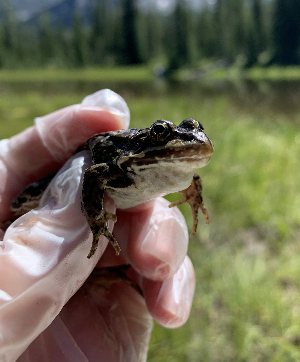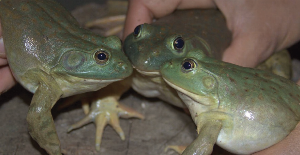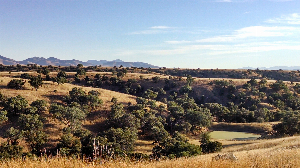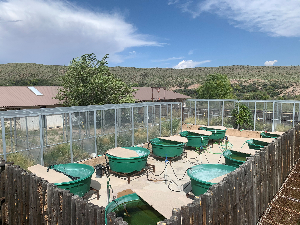Search ARMI Database
Search term(s)
Contribution Number
Search Results
146 record(s) found.
News & Stories ARMI Researchers Team-up on Nationwide Study to Determine How Interactions Between Disease and Mercury Affect Survival of Amphibians
Although it has long been known that stressors such as diseases and contaminants do not act alone, estimating how combinations of different stressors affect amphibians in the wild has generally proven elusive. A new ARMI study helps clarify the threat of the amphibian chytrid fungus (Bd), a pathogen linked with population declines and extirpations of amphibians globally. One of the most surprising results was that Bd reduced adult survival even for some species previously considered resistant to Bd, such as the Eastern Newt. This study also provides the first evidence of that methylmercury can affect survival of wild amphibians, even at sites without obvious sources of mercury contamination. In some cases, Bd and methylmercury appeared to act synergistically to magnify the effect of disease, further reducing survival. This study builds on a recent nation-wide assessment of methylmercury bioaccumulation that used non-lethal sampling, allowing researchers to sample threatened and endangered species that otherwise could not have been included in the study. This new study involved coordinated sampling by ARMI-scientists across the contiguous USA, using a multi-species, multi-population, multi-year modeling effort to provide robust results on the effects of Bd and mercury on adult amphibian survival. The results highlight the challenges associated with managing amphibian populations in the face of endemic disease combined with other environmental stressors.
To view the full article, click this link: https://doi.org/10.1038/s41598-025-99839-3
Papers & Reports Methylmercury in subarctic amphibians: environmental gradients, bioaccumulation, and estimated flux
Papers & Reports Using life history traits to assess climate change vulnerability in understudied species
Papers & Reports Assessing amphibian richness, rarity, threats, and conservation prospects for U.S. national park network [UPDATE TITLE]
Papers & Reports Assessing predictions from optimal egg theory for an ectotherm relative to habitat duration
News & Stories ARMI scientists are delegates to the World Congress of Herpetology
The 10th World Congress of Herpetology was held in the city of Kuching, in Sarawak, Malaysia (northwest Borneo) August 5 – 9. ARMI scientists Brian Halstead, Blake Hossack, Pat Kleeman, and Erin Muths presented research papers. There were over 1400 delegates at the Congress, with > 900 contributed talks and 33 symposia.
Halstead and Muths organized a symposium targeted at graduate students (What Editors Want: A Guide to the Publication Process for Graduate Students) that included talks from 7 past and present editors, including Judit Voros, co-editor of Amphibia-Reptilia and Secretary General of the World Congress.
Hossack presented a talk co-authored by ARMI scientists Kelly Smalling and Brian Tornabene titled: “Energy-related secondary salinization of wetlands: Coordinated experiments and field surveys to identify mechanistic links with amphibian abundance”. This invited talk was included in the symposium titled: Haunting the seaside: Integrative biology of salt tolerance in amphibians.
Halstead presented a talk titled: “Effects of translocation and head-starting on giant gartersnake (Thamnophis gigas) behavior and survival”, co-authored by USGS scientist A. M. Nguyen and B. D. Todd (University of California, Davis). This invited talk was included in the symposium titled: Improving conservation and mitigation outcomes of snake translocations—global lessons.
Kleeman presented a contributed talk co-authored by Halstead and J.P. Rose (ARMI scientists), and collaborators from the Nevada Department of Wildlife, K. Guadalupe and M. West, titled: Initial demographic estimates for two species of narrowly endemic toads in central Nevada: Anaxyrus monfontanus and Anaxyrus nevadensis.
Muths’ presentation, co-authored by L. Bailey, A. Fueka, L. Roberts (Colorado State University) and B. Hardy (Chapman College), was in the symposium titled: Improving animal welfare. This invited talk was titled, “Methods in marking toads: PIT tagging versus photography”.
The World Congress is held every four years on different continents with the specific aim of facilitating attendance from herpetologists around the world especially those from developing countries. The first World Congress was held in Canterbury, Great Britain in 1989, with subsequent congresses in locations including China, Brazil, Australia, and Canada. ARMI hosted a symposium on amphibian decline in 2012 at the 7th World Congress in Vancouver.
Congress delegates in Kuching enjoyed multiple plenary talks with topics ranging from Bornean flora and fauna, to the Biogeography and Evolution of reptiles in the Arabian Peninsula, to Frog diversification in Old World tree frogs.
News & Stories Effects of Harmful Algal Blooms on Amphibians and Reptiles are Under-Reported and Under-Represented
USGS ARMI scientists recently published a critical review on what is known about the effects of harmful algal blooms (HABs) on amphibians and reptiles.
HABs are a persistent and increasing problem globally in both freshwater and marine environments, yet we still have limited knowledge about how they affect wildlife. HABs can occur when colonies of algae have abundant resources, grow rapidly, and produce cyanotoxins. This natural phenomenon was first described in the late 1800s but have become more common due to increases in nutrient inputs and availability (e.g., from agriculture or runoff) and global temperatures that favor their growth.
Although semi-aquatic and aquatic amphibians and reptiles have experienced large declines and occupy environments where HABs are increasingly problematic, their vulnerability to HABs remains unclear. The current review was designed to synthesize existing information of the effects of cyanotoxins on amphibians and freshwater reptiles. The information gained by evaluating and synthesizing previous studies and reported mortality events could enhance monitoring and conservation efforts while also guiding future studies on both amphibians and reptiles.
Our review highlights how cyanotoxins can be lethal and negatively affect larval amphibians, but information on effects on reptiles or embryonic and adult amphibians is lacking, apart from a few observational studies. Cyanotoxins can have systemic effects and negatively influence reproductive, digestive, and liver function in amphibians. Given that amphibian and some reptile populations are declining worldwide, it is important to increase monitoring and experimental efforts to understand the singular and synergistic effects of these toxins. It will also be important to better understand the events that cause algal blooms to synthesize and release toxins and effects of HABs that do not produce cyanotoxins. We also propose future near-term and long-term studies that could help clarify the population-level effects of HABs on amphibians and reptiles and could enhance monitoring and management efforts, especially in areas where HABs have been documented consistently.
Papers & Reports Effects of harmful algal blooms on amphibians and reptiles are underreported and underrepresented
Data Release Mercury concentrations in amphibian tissues across the United States, 2016-2021
News & Stories Broad-Scale Assessment of Methylmercury in Adult Amphibians
The first widescale assessment of methylmercury in adult amphibians in the U.S. shows that this toxic compound is common, widespread and, at least for some populations, can reach very high levels. The ARMI-led publication brought together scientists from around the country to test more than 3,200 amphibians representing 14 species from 26 populations. Amphibians are the most endangered group of vertebrates worldwide, but prior to this study, little information was available on mercury bioaccumulation in amphibians across the U.S.
Mercury is a contaminant of global concern that can harm humans and wildlife. In aquatic ecosystems, microbes can convert elemental mercury to methylmercury, which increases risks because methylmercury is more bioavailable, more toxic, and it biomagnifies through food webs.
Study results showed that the amount of methylmercury in amphibians varied widely among sites and by life history characteristics, such as diet, size, and sex. Amphibian methylmercury concentrations ranged from barely detectible at some locations, to levels above wildlife health benchmarks in others. The study also evaluated using dragonfly larvae to estimate bioaccumulation for amphibians that can’t be sampled because they are rare or secretive. Scientists determined that the concentration found in these insects can provide insight into methylmercury bioaccumulation in amphibians.
Despite its toxicity, scientists only have a limited understanding of methylmercury’s effects on amphibians and these results can be used to inform future research on the health effects of methylmercury exposure on amphibians. The study also provides new methods and baseline data that can help scientists and managers assess the risk from mercury for species of management concern, including species listed as threatened and endangered under the Endangered Species Act.
To view the full article click this link: https://pubs.acs.org/doi/10.1021/acs.est.3c05549
Papers & Reports Genetic Connectivity in the Arizona toad (Anaxyrus microscaphus): implications for conservation of a stream dwelling amphibian in the arid Southwestern U.S.
News & Stories Successful eradication of invasive American bullfrogs leads to co-extirpation of emerging pathogens
Recent ARMI-led research showed the removal of invasive American bullfrogs from livestock ponds and small lakes in southern Arizona also resulted in the apparent local extirpation of two pathogens associated with the bullfrogs. The American bullfrog is native eastern North America but has become widespread in the West, where it preys on many native species of conservation concern. Other recent ARMI-led research from the area suggested that American Bullfrogs could act as reservoirs for pathogens like amphibian chytrid fungus (Batrachochytrium dendrobatidis; Bd) and ranaviruses, which are often lethal to native amphibians, but less so to American Bullfrogs.
In the early 2000s, American bullfrogs were eradicated from ponds in the Buenos Aires National Wildlife Refuge near the Arizona-Mexico border to assist with the reintroduction efforts for the federally threatened Chiricahua Leopard Frog. In 2015, the bullfrog reinvaded the refuge and was once again removed. This reinvasion from outside the refuge motivated funding for a multi-year, landscape-scale eradication program. In the fall-winter of 2016 and the winter of 2020-2021, the research team tested the water at bullfrog eradication and control (no eradication efforts occurred) sites for the DNA (environmental DNA or eDNA) of invasive bullfrogs, federally threatened Chiricahua Leopard Frogs, and Bd and ranaviruses.
Results from the eDNA sampling showed American Bullfrogs were eradicated successfully from most sites, and where bullfrogs were eradicated, the pathogens were also no longer detected. Chiricahua Leopard Frogs did not increase in occurrence after eradicating bullfrogs, possibly due to an exceptional drought that could have limited the ability of native amphibians to colonize sites.
To our knowledge, this is one of the few studies to link eradication of an invasive species to co-eradication of emerging pathogens. Our spatially replicated experimental approach provides strong evidence that management of invasive species can simultaneously reduce predation and disease risk for imperiled species.
To view the full article click this link: https://doi.org/10.1111/conl.12970
Papers & Reports A Dataset of Amphibian Species in U.S. National Parks
Papers & Reports Broad-scale Assessment of Methylmercury in Adult Amphibians
Papers & Reports Assay validation of saliva glucocorticoids in Columbia Spotted Frogs and effects of handling and marking
Papers & Reports Successful eradication of invasive American bullfrogs leads to co-extirpation of emerging pathogens
Papers & Reports Broad-scale assessment of methylmercury in adult amphibians
Papers & Reports Looking ahead, guided by the past: The role of U.S. national parks in amphibian research and conservation
News & Stories Collaborative Study Measures Effects of Invasive Bullfrogs on Native Amphibians and Pathogens of Conservation Concern
A new collaborative study provided evidence that invasive, non-native American Bullfrogs influence the occurrence of native amphibians and increase occurrence of pathogens, including ranaviruses and amphibian chytrid fungus (Bd). These pathogens can cause lethal diseases of amphibians and have been linked with widespread population declines. ARMI scientists partnered with collaborators from Arizona Game and Fish Department, US Fish and Wildlife Service, Turner Endangered Species Fund, University of Arizona, Washington State University, and National Autonomous University of Mexico (UNAM) to analyze water samples from 233 sites in the southwestern USA and northern Sonora, Mexico, for the presence of environmental DNA (eDNA). Federally threatened Chiricahua Leopard Frogs and Western Tiger Salamanders were 8 times and 2 times, respectively, less likely to occur at sites where bullfrogs occurred. Ranaviruses were 10 times and Bd was 2.5-times more likely to be present at sites with bullfrogs than without bullfrogs. These results provide evidence that bullfrogs reduce occurrence of native amphibians and can increase occurrence of pathogens. This information can clarify risks for native species and aid in the prioritization of conservation actions.
Paper:
Hossack, B. R., E. B. Oja, A. Owens, D. Hall, C. Cobos, C. L. Crawford, C. S. Goldberg, S. Hedwall, P. E. Howell, J. Lemos-Espinal, S. MacVean, M. McCaffery, E. Muths, A. H. McCall, C. Mosley, B. H. Sigafus, M. J. Sredl, and J. C. Rorabaugh. 2023. Empirical evidence for effects of invasive American Bullfrogs on occurrence of native amphibians and emerging pathogens. Ecological Applications e2785. https://doi.org/10.1002/eap.2785
News & Stories ARMI scientists lead analysis of factors linked with long-term reintroduction success for a threatened frog
Reintroduction programs are growing in use to help recover imperiled species. However, there is still little information on the long-term success of these programs or factors linked with successful establishment of populations. ARMI scientists collaborated with partners from the US Fish and Wildlife Service, Arizona Game and Fish Department, Turner Endangered Species Fund, and university scientists to analyze 25 years of reintroductions for the Chiricahua Leopard Frog in Arizona and New Mexico. The reintroduction program stocks larvae and frogs reared in several captive and semi-captive facilities in the region, as well as egg masses and frogs moved from wild sources. The results from the study can help improve reintroduction success and speed recovery for the Chiricahua Leopard Frog and other species with similar life histories.
Citation
Hossack and others. 2022. Identifying factors linked with population persistence: Lessons learned from 25 years of amphibian translocations. Global Ecology and Conservation 35: e02078. https://doi.org/10.1016/j.gecco.2022.e02078








